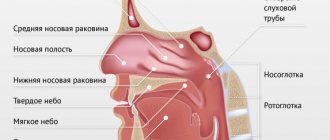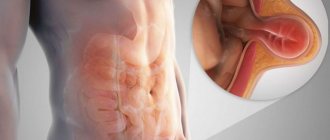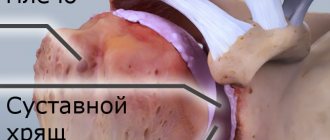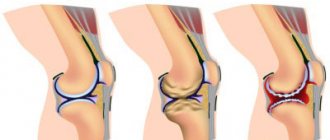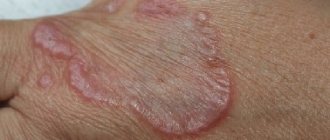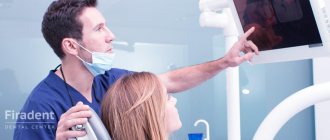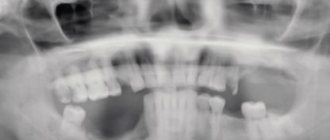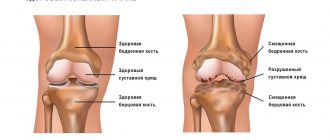Autoimmune arthritis
is a disease that appears as a result of disorders that occur in the immune system when one’s own tissues are perceived as foreign. Immune cells against them begin to produce special proteins that cause an inflammatory process in the lining of the joints, cartilage and blood vessels. There are several forms of arthritis, many of which are autoimmune in nature.
Causes of the disease
Inflammation of the joints of the musculoskeletal system is a pressing problem for modern people. Rheumatoid arthritis, which is a type of autoimmune disease, mainly affects people of working age after forty years, and it is five times more common in women than in men. The main causes of joint disease are considered to be:
- Genetic predisposition associated with abnormal chromosome structure. Blood relatives are four times more likely to have rheumatoid arthritis.
- Infections - viral diseases: rubella, herpes, retrovirus, Epstein-Barr. All of them are factors contributing to the development of the inflammatory process in the joints.
- Unfavorable environmental conditions: radioactive radiation, constant exposure to low temperatures, chemical pollution.
- Systematic stressful situations, emotional overload. Autoimmune arthritis in the female half of the population often occurs during pregnancy, after childbirth, abortion, and during menopause.
- Rapid increase in body weight.
- Alcohol and tobacco addiction.
All of the above factors contribute to the development of the inflammatory process, primarily in the cartilage tissue of the joints.
Rheumatoid arthritis: what is it and how is it treated?
Rheumatoid arthritis is an autoimmune-inflammatory disease. It affects more often women of different ages, and the joints of the ankles, knees, hands and ankles are affected.
It is believed that the cause of rheumatoid arthritis is a malfunction of the immune system, and provoking factors are hypothermia, stress, infection or injury. The mechanism of joint destruction can be triggered by influenza, tonsillitis or a common ARVI. Recognizing the disease is quite simple:
- the joint swells and hurts (swelling can last from several months to several years);
- joints are affected symmetrically - on both arms or legs;
- the pain intensifies at night or in the morning, subsides or goes away in the evening;
- rheumatoid nodules the size of a pea form in the joint; they are dense to the touch;
- weakness, loss of appetite, chills and a slight increase in temperature are present.
Unlike arthrosis, in which pain, on the contrary, intensifies after physical activity, with rheumatoid arthritis, warming up the joint helps get rid of discomfort.
Over time, the joints become deformed and limited in mobility. The disease affects all new joints. Pathological fluid accumulates in the knee - a Baker's cyst is formed with the risk of rupture. The cervical spine often becomes inflamed - pain appears in the neck and under the back of the head.
Sometimes people with rheumatoid arthritis lose significant weight
Symptoms
In the early stages, the disease is most often relatively mild, so patients do not immediately seek medical help. Symptoms of autoimmune arthritis develop gradually, and the development of a full clinical picture of the disease takes several years. Most often, at the very beginning of the onset of the disease in adults, small joints are affected, especially the hands, and in children, on the contrary, large joints are affected. During this period, the patient has only general symptoms. These include:
- weakness;
- malaise;
- loss of appetite;
- weight loss;
- low-grade fever.
The main signs of illness are:
- Morning soreness and joint stiffness for an hour or longer.
- Painful sensations and swelling.
- Characterized by symmetrical damage to the joints of the right and left sides.
- Limitation of functions due to swelling of the joints.
As autoimmune arthritis develops, the following characteristic signs occur:
- Typical deformation of the hands and feet.
- The occurrence of muscle destruction.
- Disintegration of damaged joints, compression of fibers.
In the final stages of the disease, the following are possible:
- The appearance of rheumatoid nodules that do not cause pain.
- Enlarged lymph nodes.
- Inflammation of blood vessels.
- Pathological processes in the kidneys and lungs.
- Heart problems.
- Osteoporosis.
- Gastrointestinal diseases.
- Neuropathy.
- Eye lesions.
Autoimmune disease (arthritis) leads to damage to all organs and damage to small joints of the limbs. Due to the fact that a person may not experience typical joint pain for a long period of time, he comes to see a doctor when significant changes have already occurred in the cartilage and joints, which greatly complicates treatment.
Degrees and stages of knee arthritis
There are 4 stages of the pathological process:
- Arthritis of the knee joint 1st degree. There are usually no obvious symptoms. There may be slight morning stiffness of the joint, slight swelling, and increased fatigue. With grade 1 arthritis of the knee joint, the pain is not severe and is periodic and irregular (“pinched”). At this stage, doctors usually give a positive answer to patients' questions about whether knee arthritis can be cured. A complete cure is possible.
- Arthritis of the knee joint 2 degrees. The pain syndrome is noticeably expressed, swelling of the joint is clearly visible. An unpleasant crunching sound may occur when bending your legs. With grade 2 arthritis of the knee joint, redness of the skin and a local increase in temperature begin.
- Arthritis of the knee joint grade 3. From the side, the deformation of the joint is noticeable, the patient’s gait changes. The pain is felt constantly, interfering with normal daily activities and significantly limiting the patient even when taking medications for knee arthritis.
- Arthritis of the knee joint 4 degrees. The joints become ankylosed (fused) and almost completely lose mobility. Irreversible changes affect the bones. The leg muscles suffer from contractures, and the ligaments shorten. At this stage, surgery is required.
Diagnostics
At first, exacerbations appear in the form of minute attacks, and sometimes last for several days. But abnormal changes in the immune system begin to occur long before obvious signs of illness. It is very important not to miss the initial symptoms of the disease and to visit the clinic on time. Patients often ask: their joints hurt, which doctor should they see? If you don’t know which doctor to visit, you can always ask about it at the reception desk or go to an appointment with a therapist who will examine you and give you a referral to the necessary specialists: a neurologist, rheumatologist, orthopedist and surgeon. Timely detection of the disease makes it possible to slow down its development and improve the patient’s quality of life. When visiting a doctor with a patient, the following is carried out:
- a conversation during which complaints, duration and characteristics of the disease are clarified;
- external examination and palpation are performed;
- a complete anamnesis is collected.
After this, the following laboratory tests are performed to diagnose autoimmune arthritis:
- Clinical blood test - a characteristic feature is an increased erythrocyte sedimentation rate; with the development of the disease, a decrease in hemoglobin occurs.
- Biochemical blood test - nitrogenous waste is detected, the functioning of the liver, pancreas, carbohydrate metabolism is assessed, and blood clotting is checked.
- Blood test for antibodies - their presence and concentration is detected.
- C-reactive protein indicates the development of an inflammatory process.
In addition, to make an accurate diagnosis of autoimmune arthritis, the following hardware tests are prescribed:
- Radiography is one of the important diagnostic methods: determines the presence of damage due to injuries; changes associated with inflammation; joint deformation; bone tissue growth; changes in the joint cavity.
- Ultrasound is often used to identify changes in large joints.
- CT scan – allows you to see the condition of soft tissues.
- MRI is widely used to monitor changes in ligaments, intervertebral discs, and muscle structures.
- Scintigraphy - this method is often used to diagnose arthritis (ICD-10 code M05-M99) and can detect the disease in the early stages.
- Arthroscopy – often used for the knee joint.
- Puncture - performed to take synovial fluid for the purpose of its subsequent study.
After the results of all studies are ready, consultations with specialists are made, an accurate diagnosis is made and appropriate treatment is prescribed.
Prevention of arthritis in children
First of all, it is necessary to eliminate, if possible, all provoking factors. Of course, if we are talking about genetic predisposition, then there is nothing much you can do. But you can treat a sore throat in time, properly distribute physical activity, provide the child with proper nutrition, avoid contact with people with ARVI, harden up, follow a work-rest schedule, periodically take multivitamins, and so on.
If your family has close relatives with arthritis, it is recommended to visit a rheumatologist at least once a year for a preventive examination. This will allow you to identify arthritis in the early stages and begin treatment in a timely manner.
Sources:
- Chronic arthritis in children. Bregel L.V., Knyazeva T.S., Krupskaya T.S., Baturina L.M. Siberian Medical Journal (Irkutsk), 2002. p. 100-104
- Problems of early diagnosis of arthritis. Kazantseva N.Yu. Siberian Medical Journal (Irkutsk), 2007. p. 28-29
- Arthritis in primary immunodeficiencies. Boyarchuk O.R., Volyanskaya L.A., Kovalchuk T.A., Kinash M.I. Pain. Joints. Spine No. 1, 2017. p. 15-20
The information in this article is provided for reference purposes and does not replace advice from a qualified professional. Don't self-medicate! At the first signs of illness, you should consult a doctor.
Therapy methods
The most important tasks in the treatment of arthritis are:
- Reducing the inflammatory process in the synovial area to maintain and normalize the dynamic ability of the joints.
- Preventing the development of a destructive process.
Treatment methods for autoimmune arthritis include a whole range of different measures:
- Relieving symptoms – most often you have to deal with painful sensations. They can be easily treated with NSAIDs.
- Basic therapy - it begins immediately after the disease is detected. With the correct prescription of drugs, it is possible to relieve inflammation and achieve remission for a long period. First-line drugs, for example, Methotrexate, are especially effective; second-line drugs are less effective and are used if the first are intolerant.
- Local treatment - rubbing with ointments and other means are used, for example, compresses for joints with Dimexide.
- Physiotherapeutic procedures eliminate inflammation and reduce pain. Used at various stages of the disease.
- Surgical intervention is used extremely rarely if there is no effect from conservative treatment.
- Folk remedies - used only after consultation with a doctor. Very often, traditional healers recommend burdock and bay leaves.
- Dietary nutrition is an invariable condition for the successful fight against arthritis.
Drug therapy
The following groups of drugs are used to treat autoimmune joint disorders:
- The main ones help slow down destructive and inflammatory processes in the joints: Chlorbutin, Cyclophosphamide, Plaquenil. To suppress autoimmune failure, medications are selected by an immunologist. They help restore immune processes.
- Local – medical products used for external use. They relieve inflammation, swelling, and reduce pain in the affected joint. For this purpose, compresses with Dimexide are prescribed for joints affected by arthritis, as well as Hydrocortisone and Novocaine.
- Symptomatic – non-steroidal drugs that have an anti-inflammatory and analgesic effect. These include: Ibuprofen, Voltaren, Ketonal.
Treatment requires long-term use of medications that have serious side effects. Therefore, constant laboratory monitoring of their effects and timely detection of side effects is necessary. To achieve success, it is very important to follow all the recommendations of your doctor and trust him.
Physiotherapy
Physiotherapy is an integral part of complex treatment for arthritis (ICD-10 code M05–M99) of the joints. Some of them are used during the acute period of the disease. Procedures that are done for inflamed joints:
- electrophoresis with glucocorticoids;
- ultraviolet radiation.
They relieve inflammation and pain.
At other stages of the disease the following is prescribed:
- magnetic therapy;
- laser irradiation;
- phototherapy using lamps;
- massage and self-massage;
- mud baths;
- hydrotherapy.
Therapeutic gymnastics is very important for damaged joints. It helps improve their mobility and prevents the formation of adhesions. The patient should perform exercises daily from the very beginning of the diagnosis, excluding the time of exacerbation of the disease. In addition, patients with autoimmune arthritis should receive an annual course of sanatorium-resort treatment, and the use of essential medications is not canceled.
Treatment of knee arthritis
Treatment for knee arthritis is specific to each type of disease. For example, with rheumatoid arthritis, patients require immunosuppressive therapy, with infectious arthritis - taking antibiotic drugs to treat arthritis of the knee joint, with gout and the like - treatment of the underlying disease.
Below we will look at drugs common to all types of arthritis for the treatment of arthritis of the knee joint and techniques that help stop the inflammatory process, maintain joint mobility and relieve pain.
How to treat knee arthritis with medication?
For the drug treatment of knee arthritis, the following pharmacological groups of drugs are used:
- Nonsteroidal anti-inflammatory drugs for the treatment of knee arthritis (NSAIDs or NSAIDs) in the form of tablets, ointments, gels and creams. Tablets are prescribed in courses in the acute phase of the disease, while external agents can be used continuously.
- Glucocorticoids (GC). These hormonal drugs are used in short courses, no more than several times a year, strictly according to doctor’s indications. Drug treatment of knee arthritis with GCs is prescribed for severe pain and ineffectiveness of NSAIDs - often in the form of intra-articular injections. The effect after administration is achieved within the first seconds.
- Antispasmodics and muscle relaxants. They help relax muscles, improve joint nutrition and alleviate pain. Most often used for post-traumatic arthritis.
- Angioprotectors and warming agents. Strengthen the walls of blood vessels and improve blood circulation - and therefore nutrition of the knee joint. Also recommended for post-traumatic and other types of arthritis.
- Antienzyme and anabolic agents. The first tablets for arthritis of the knee joint restrain degenerative processes in the tissues of the joint, and the second accelerate their regeneration.
- Chondroprotectors, vitamin-mineral and restorative complexes. In the drug treatment of knee arthritis, drugs from these groups are used for healthy synthesis of cartilage tissue and prolongation of remission.
Basic drugs - tablets for knee arthritis - are used only for rheumatoid gonarthritis. Such drugs for the treatment of arthritis of the knees help preserve the volume of red bone marrow and reduce the activity of the autoimmune disease.
Treatment of knee arthritis with tablets
Treatment of knee arthritis with tablets usually involves the use of drugs such as:
- NSAIDs: ibuprofen, nimesulide, meloxicam, diclofenac, ketoprofen, piroxicam, napraxen, indomethacin, butadione and others;
- glucocorticosteroids: hydrocortisone, diprospan;
- vasodilators: pentoxifylline (trental), aminophylline, theonicol;
- muscle relaxants: tolperisone, tizanidine;
- chondroprotectors: artracam, artradol.
Tablets for knee arthritis should be prescribed by a doctor.
Ointments in the treatment of knee arthritis
Ointments for arthritis of the knee joint have an analgesic, anti-inflammatory, warming effect, improve blood circulation, elasticity of ligaments and muscles, and also distract from pain and discomfort.
The most popular drugs are voltaren-gel, menovazin, finalgon, nicoflex, fastum-gel, dolobene, diclofenac-gel, dollit-cream, ketonal-gel, indometacionic, butadionic ointment and others.
Ointments for arthritis of the knee joint can be used constantly, but there are restrictions for preparations based on bee and snake venom: they can provoke allergies and inflammation of the skin, they cannot be used by women during menstruation and children.
Treatment of knee arthritis with injections
Treatment of knee arthritis with injections (intra-articular injections) is indicated in cases where the active substance must be quickly delivered to the joint. Sometimes antibiotics are administered in this way for infectious arthritis. But most often, injections for knee arthritis include glucocorticoids. For rapid pain relief and inflammation relief, prednisolone and methylprednisolone, hydrocortisone, triamcinolone and others are used.
Surgical treatment of arthritis in the knee joint
Surgical intervention is recommended for chronic arthritis in the later stages, as well as to remove effusion or pus from the joint capsule. Depending on the symptoms and treatment of knee arthritis, your doctor may prescribe the following surgeries:
- Puncture. A minimally invasive technique in which a special needle is inserted into the joint to pump out fluid and, if necessary, administer a drug.
- Synovectomy. Excision of the synovial membrane is carried out to reduce pain, eliminate inflammatory foci and contain destructive processes in the joint.
- Arthroplasty and endoprosthetics. Replacing a diseased joint with a prosthesis, partially or completely, is recommended when the joint is almost completely immobile, when surgery is more effective than treating arthritis of the knee joint. This complex operation helps restore knee function for up to 20 years.
Physiotherapy for knee arthritis
Physiotherapy is used to treat chronic arthritis and is prohibited in the acute stage of the disease (except for certain types of magnetic pulse therapy). Physiotherapeutic techniques enhance the effect of medications, improve joint mobility and nutrition, and have a strengthening effect on muscles. They also stimulate tissue regeneration in the joint and immunity, effectively combat contractures, swelling, inflammation and pain. The most common physiotherapeutic procedures for gonarthritis include:
- laser therapy;
- magnetic therapy;
- ultrasound therapy;
- UHF therapy;
- acupuncture (acupuncture);
- diadynamophoresis;
- amplipulse;
- exercise therapy complex for knee arthritis;
- mud therapy and paraffin therapy;
- massotherapy.
Diet for arthritis
It is very important to observe limited nutrition in case of autoimmune disorders, not only during exacerbation of the disease, but also during remission. Dietary nutrition involves excluding fatty and fried meat and fish products, strong broths, canned food and semi-finished products from the diet. It is necessary to reduce the consumption of salt and sugar. It is not advisable to eat corn, whole dairy products, wheat porridge and rye bread. Dishes consisting of products of plant origin, lean sea and river fish, lean poultry, rabbit and calf are useful for arthritis. For drinking, use infusions of rose hips and herbs, fruit drinks from berries, green tea, and mild mineral water without carbonation.
Surgery
Experts resort to surgical intervention for arthritis only when all methods of conservative therapy have been tried. During surgical intervention, the use of two techniques is of greatest importance:
- synovectomy – removal of the articular synovial membrane;
- complete joint replacement with an endoprosthesis.
The decision to replace a joint is made by an orthopedist together with a rheumatologist. The operation is performed when the joint is very deformed and has lost its ability to move. And the most important thing is the patient’s desire to undergo surgery. In this case, the postoperative period is much more successful. An artificial prosthesis can last from 5 to 15 years. The patient needs to take care of the new joint and limit its mobility.
Chronic disease of joint tissues, which subsequently affects cartilage and bone structures, is a very serious illness. In the absence of proper therapy, it constantly progresses and leads to disability. Only comprehensive treatment and patient compliance with all doctor’s recommendations leads to remission.
Don't delay your visit to the doctor. Self-medication, as well as unauthorized withdrawal of medications, is unacceptable for this disease. They will result in deterioration of health and progression of the disease.
You can make an appointment at the Canon clinic on the website or by phone +7


